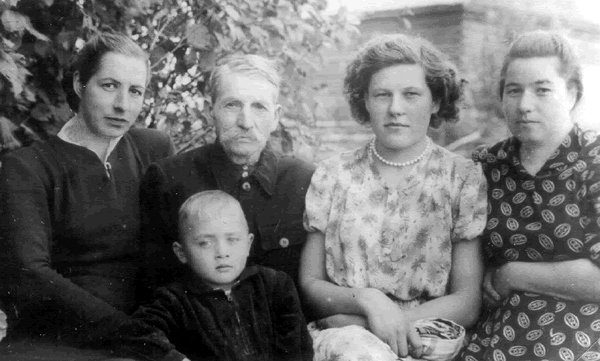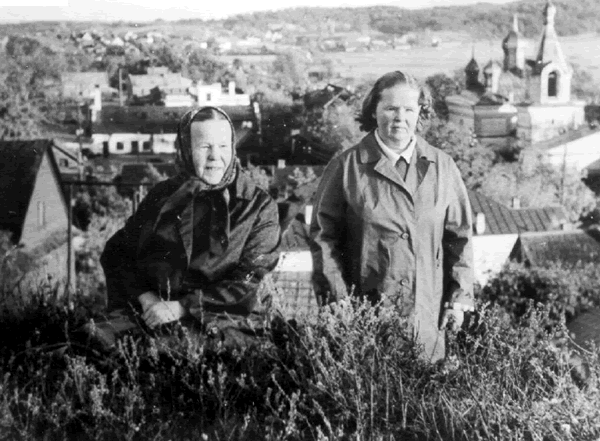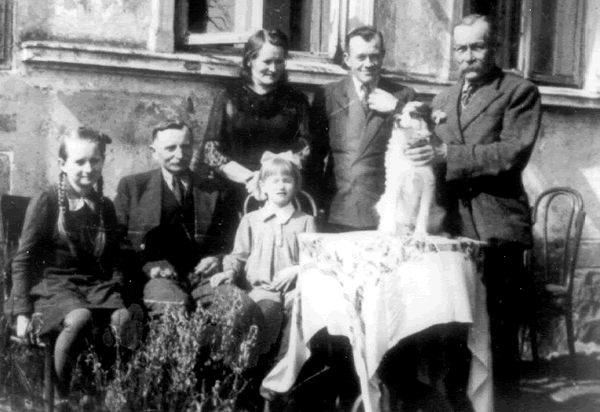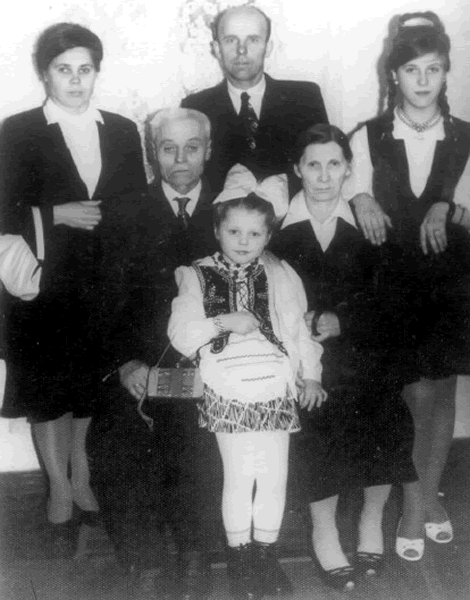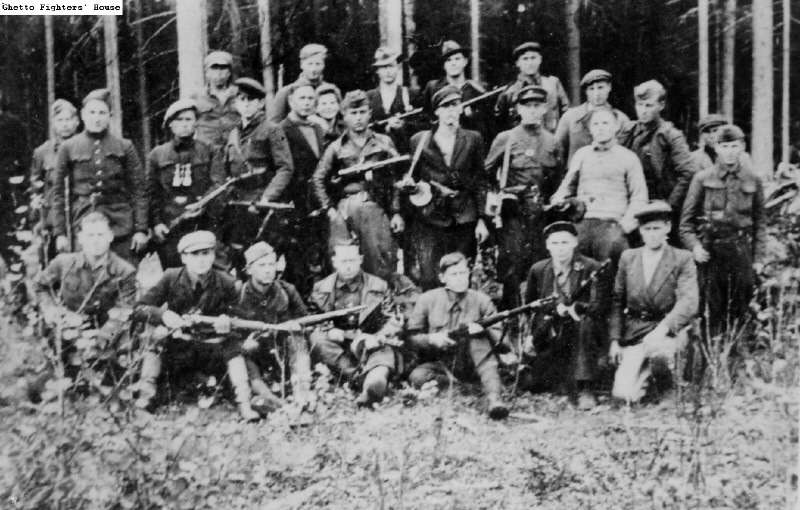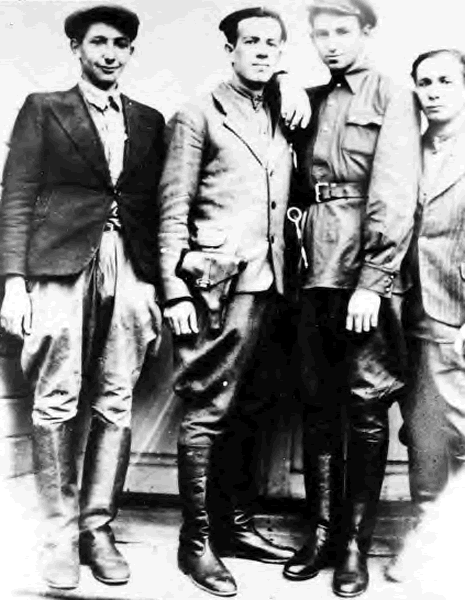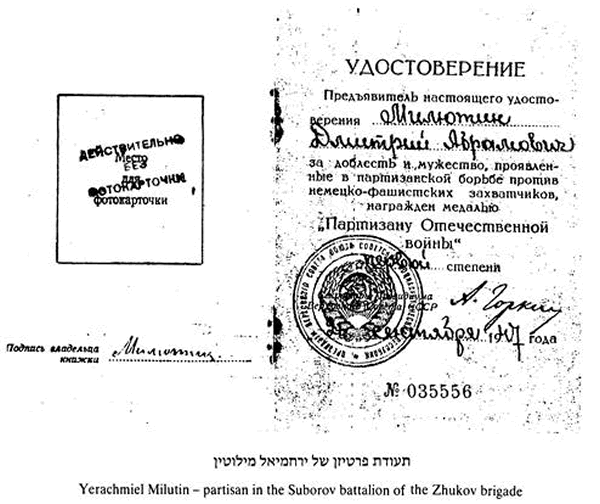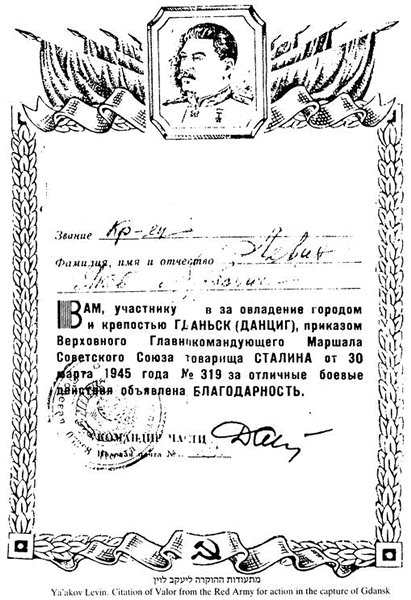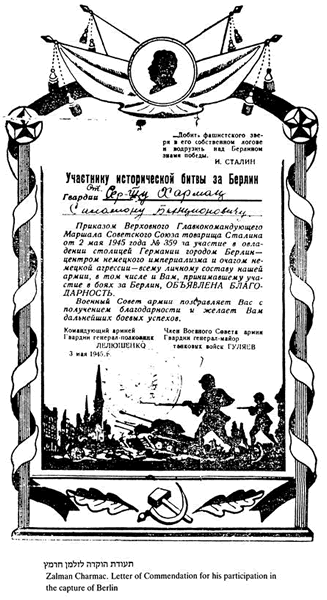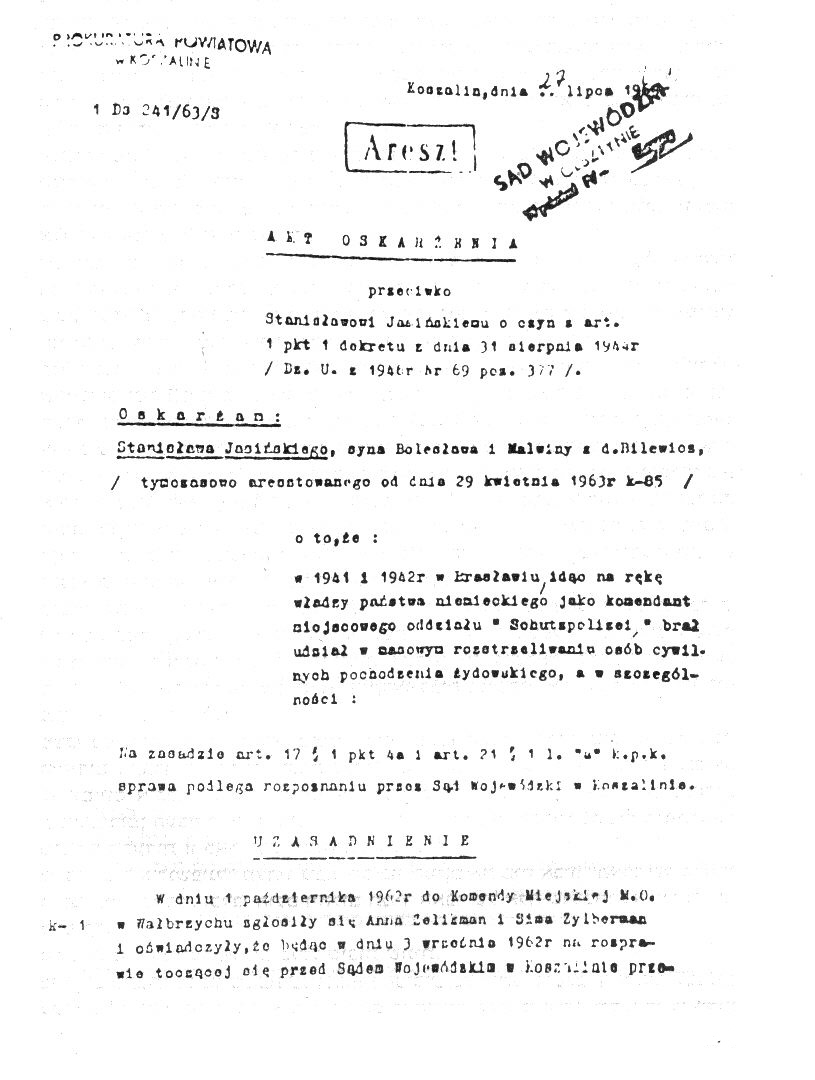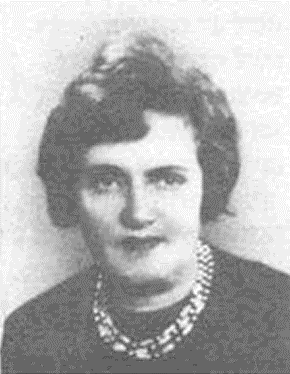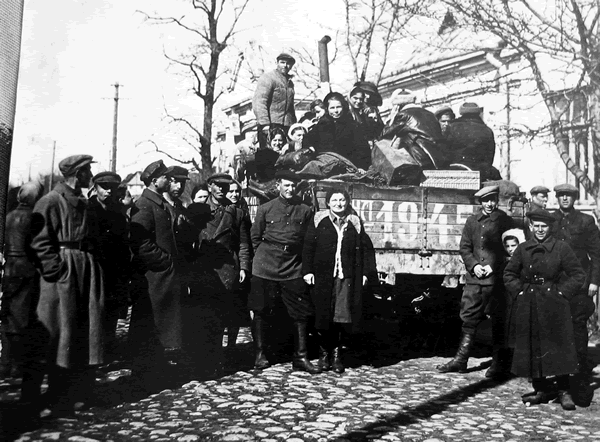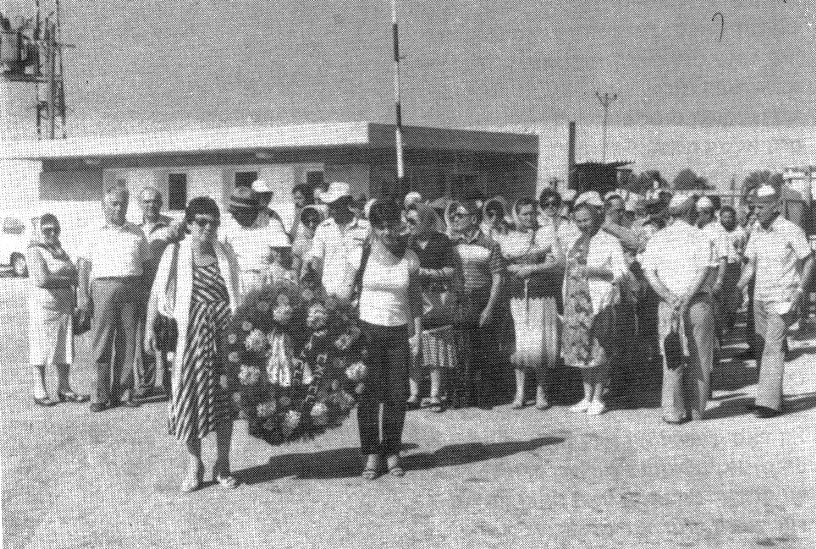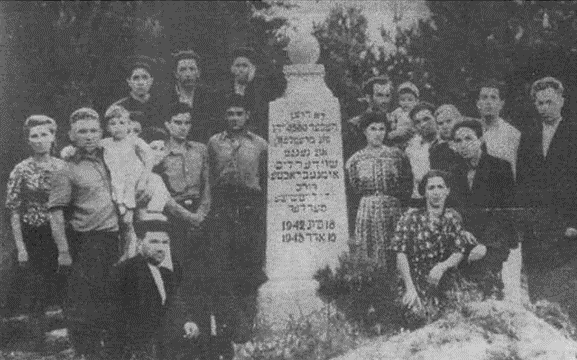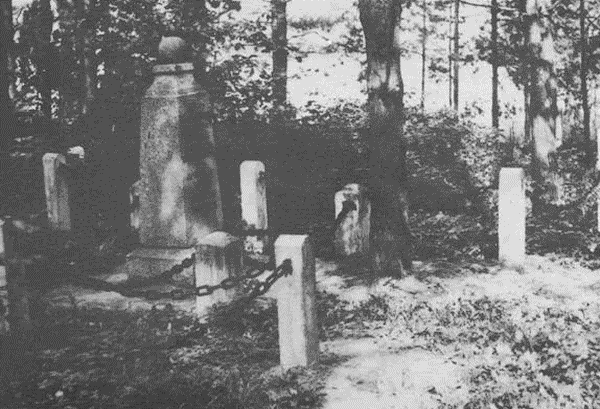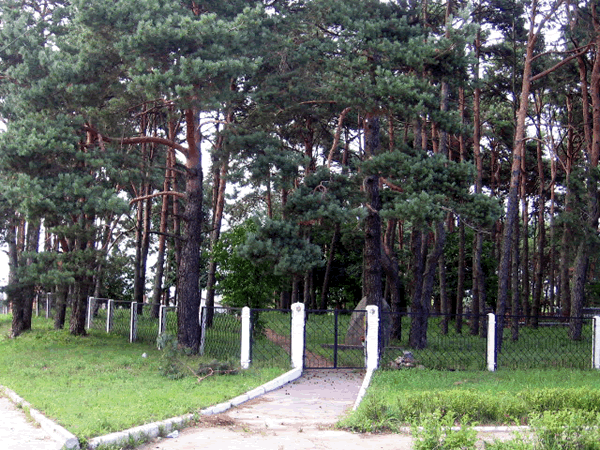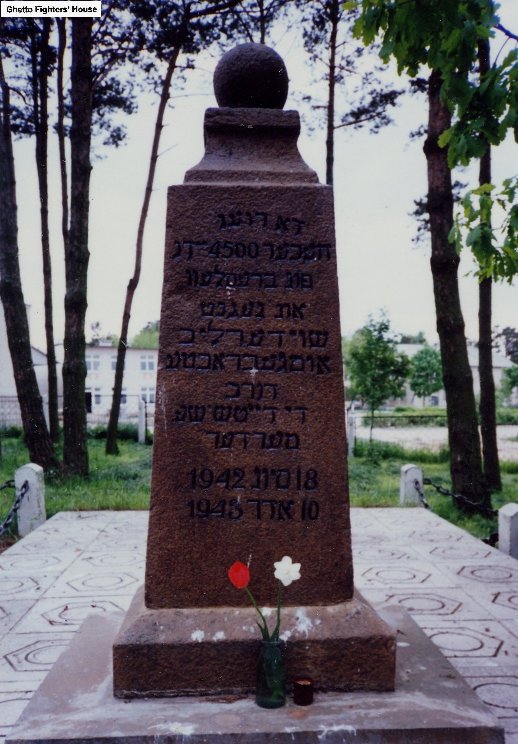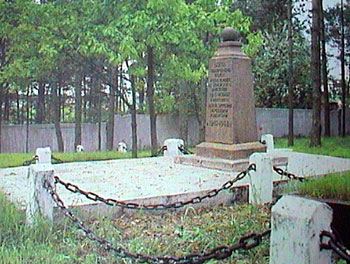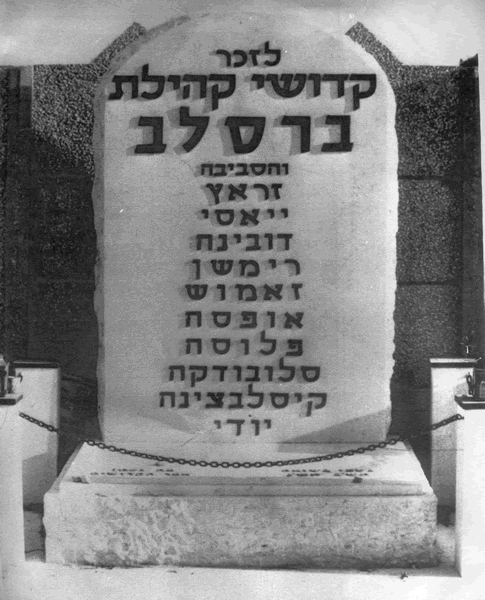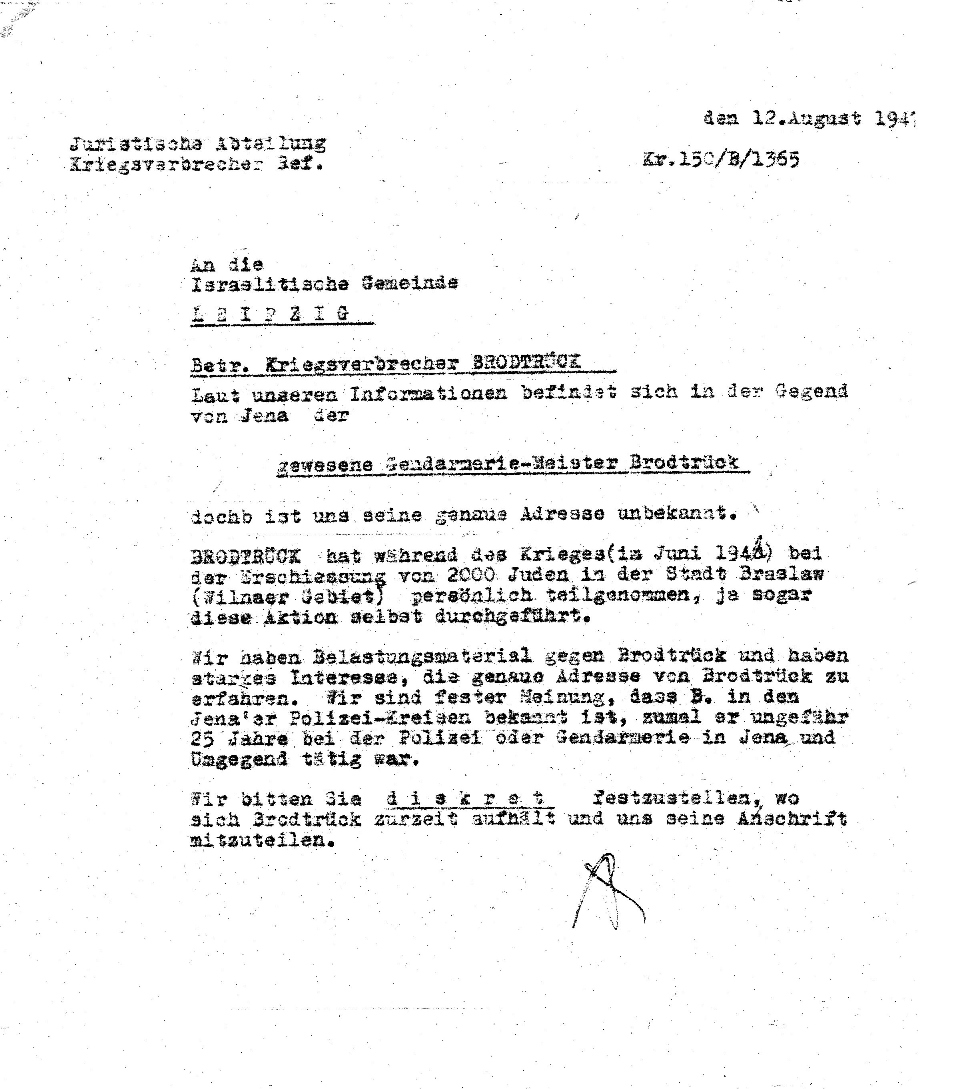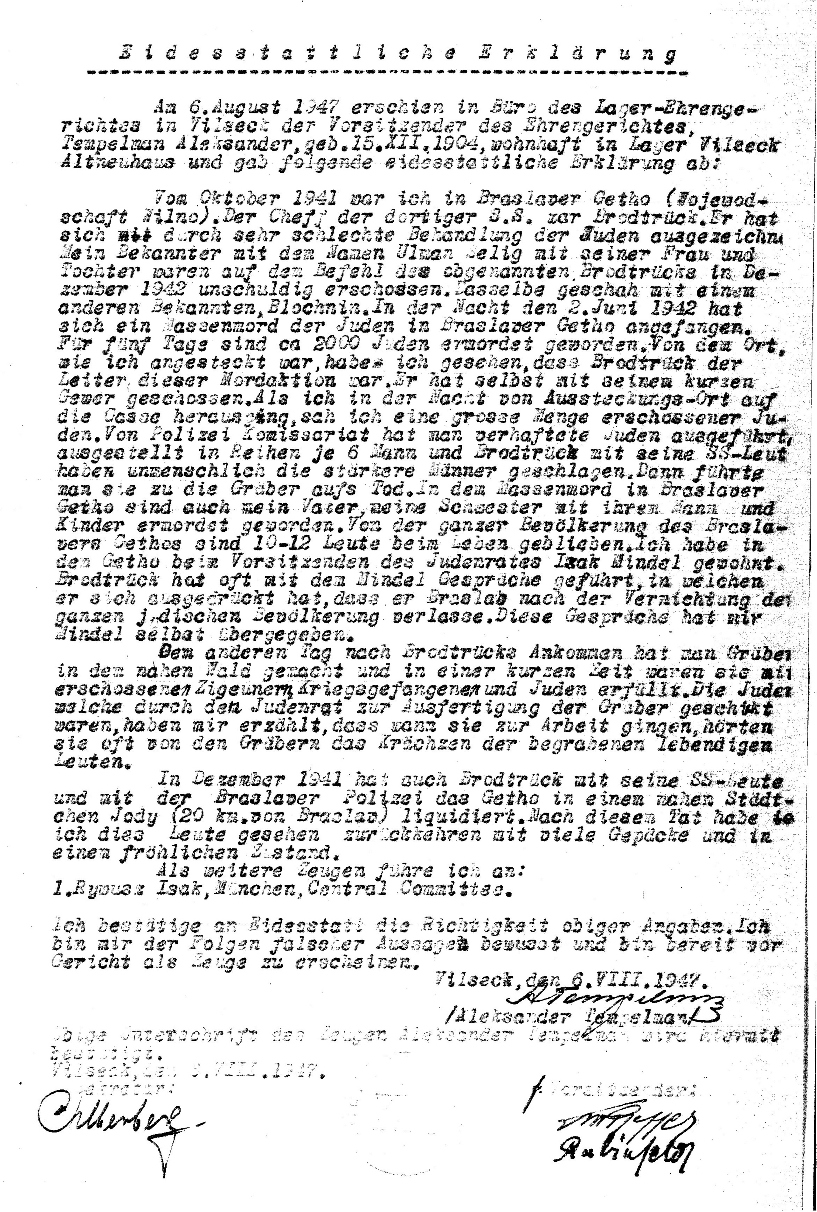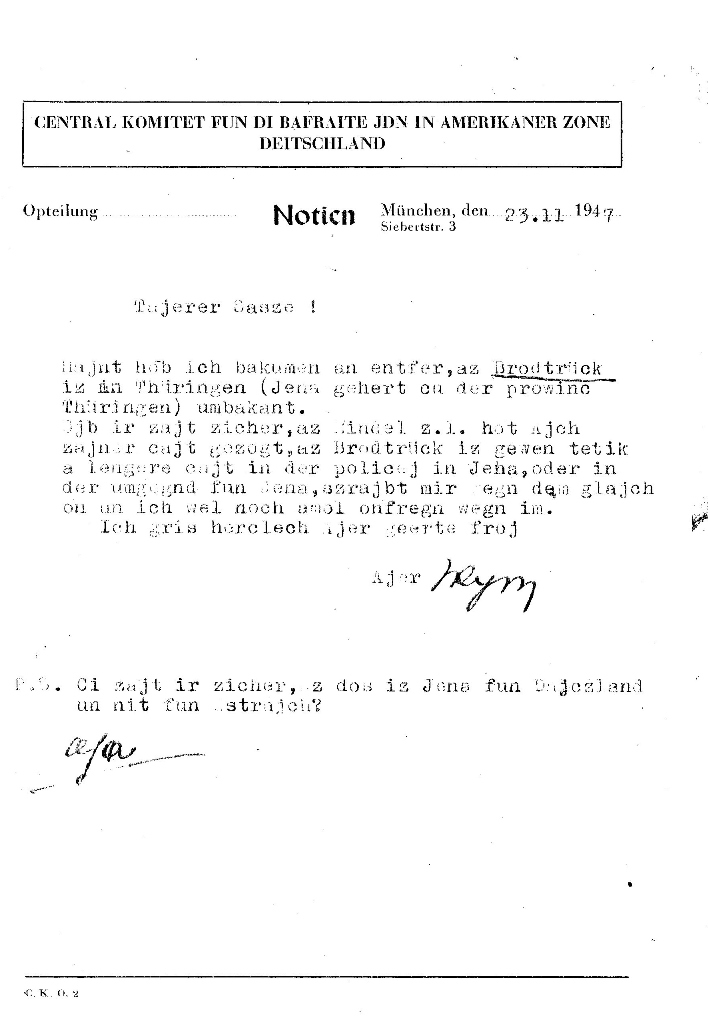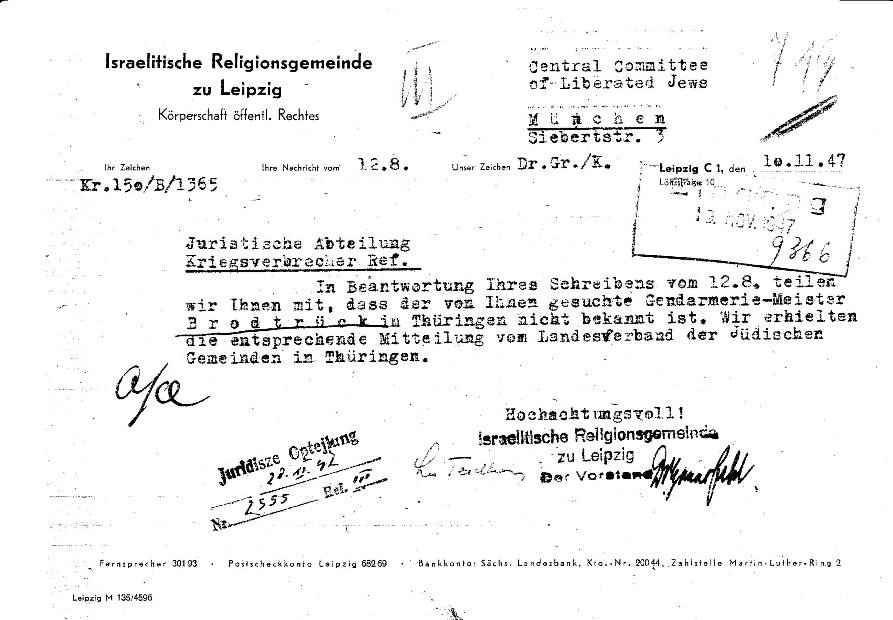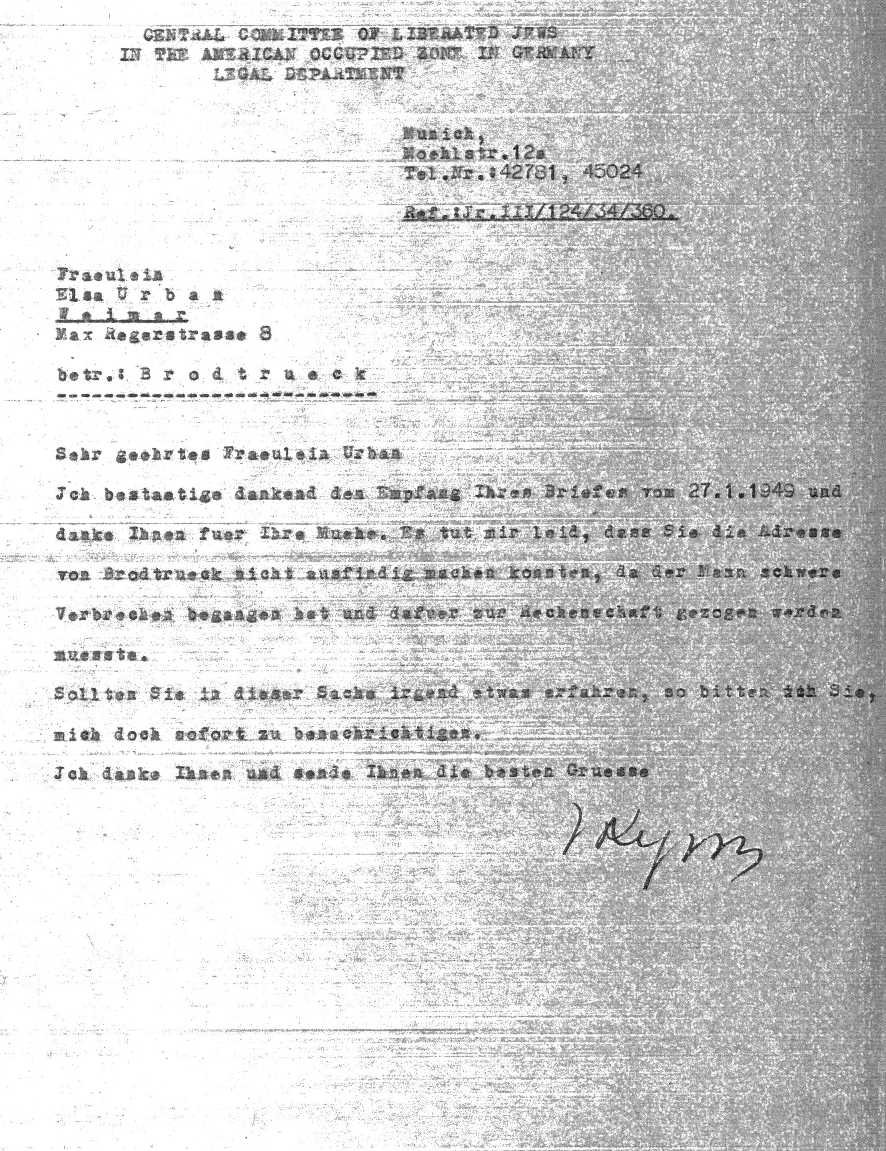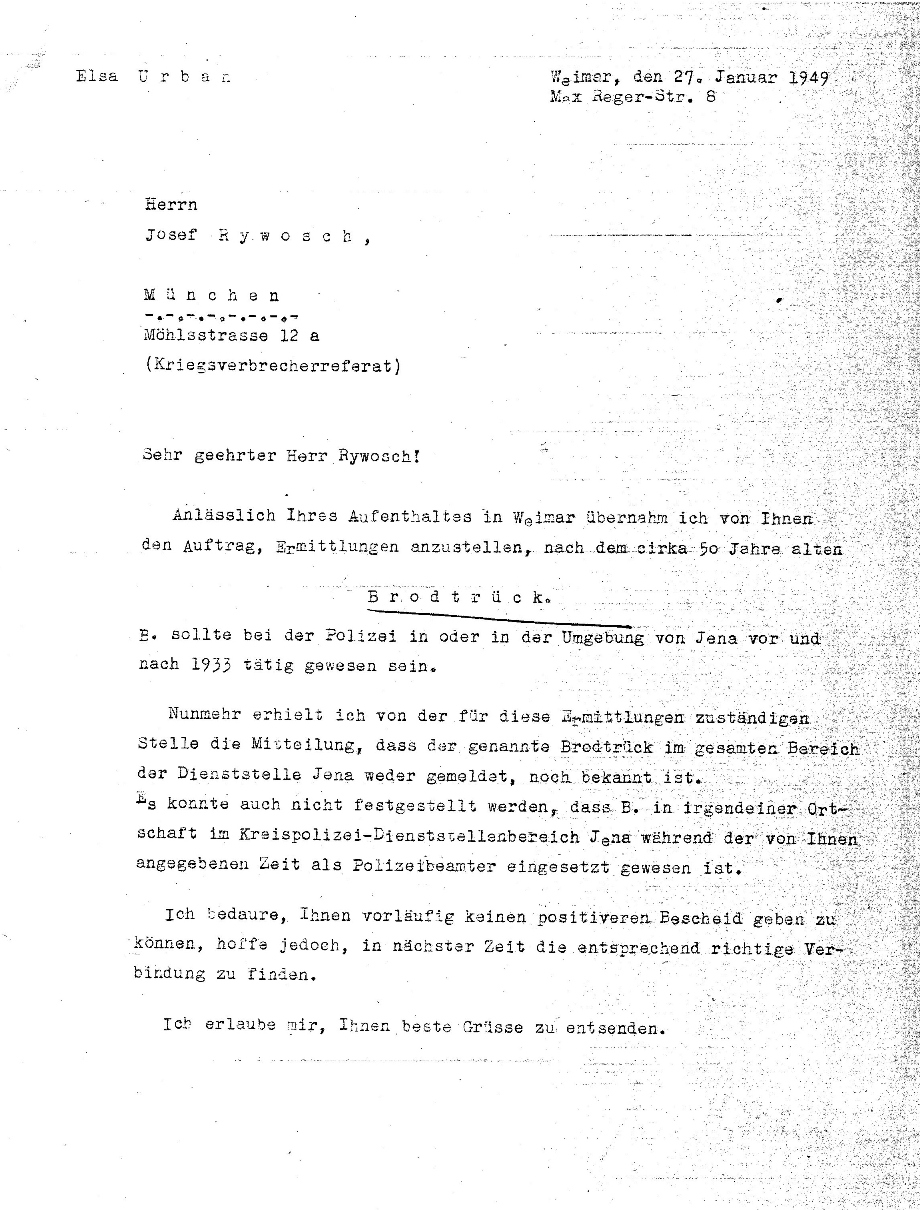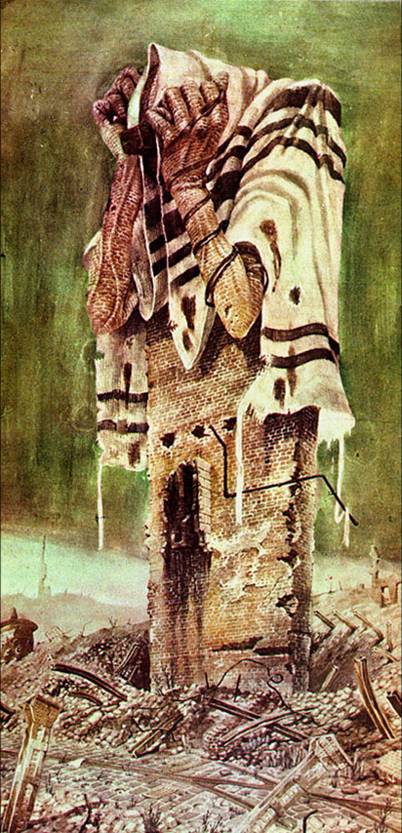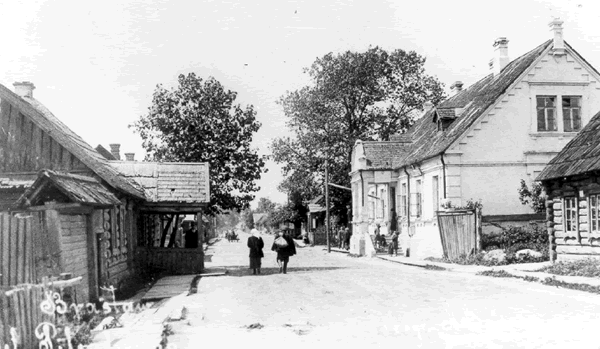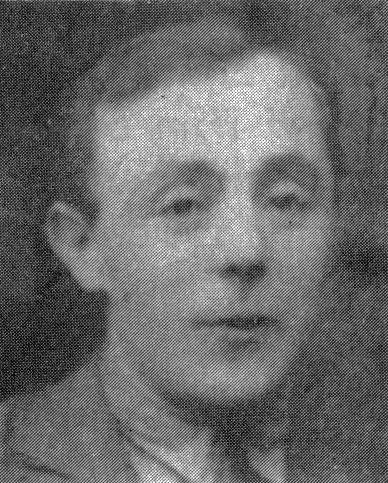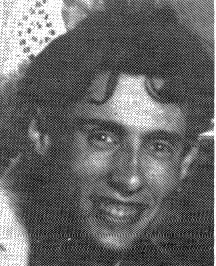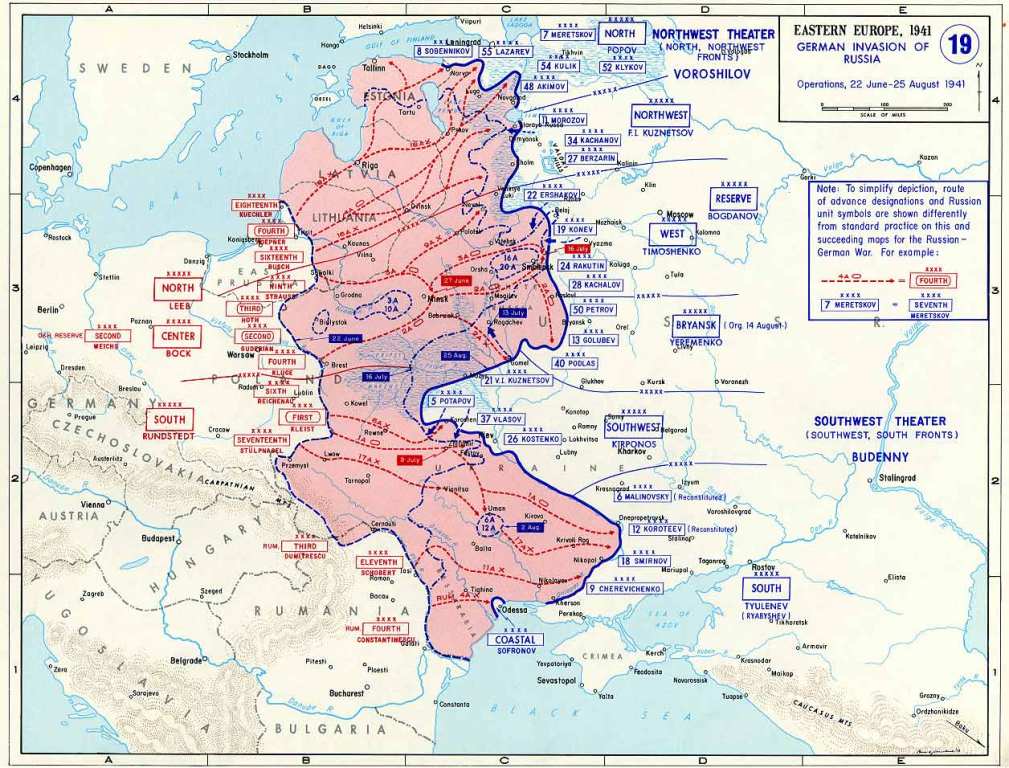The Bajnarowicz family who rescued the Schmidt family.
Emilia and Jadzia Czesnowicka who hid the Maron and Fischer families in a bunker in the cow barn beside their home, from June 1942 to July 1944.
The Szczerwinski family who saved Yetta Wiszkin Fischer and her three cousins.
The Szakal family who rescued the Lubowicz & Blacher families
Partisans
The Braslav district was a centre of Jewish partisan activity, much of it based on escapees from the ghetto and from the surrounding shtetlach. For example Yerachmiel Milutin of Braslav, was second-in-command of an intelligence group in the partisan unit Zhukov. He and eight others were dispatched on a certain operation but encountered Nazi soldiers who opened heavy fire on them. While many of his men fled, Milutin held his ground, and with concerted fire and hand grenades caused the enemy great losses and saved his own men.
Another partisan was Faivel Trok of Jod who escaped the Vidz ghetto in June 1942 and joined the Ponomarenko partisan unit which was active in the Glubokie district. He took part in attacks German military barracks, on railway bridges and in reprisals against collaborators.
And then there was Pinhas Jaffe and his son from Bildziugi near Jod who fled the shtetl prior to its liquidation. After fleeing to the forest they joined a band of other Jews who had escaped nearby ghettos and formed a partisan unit. Their actions mostly comprised of avenging attacks on collaborators, local German administrators and those who had handed Jews over to the Nazis. On December 15th, 1942 Pinchas and his son Motel
The Braslav district was a centre of Jewish partisan activity, much of it based on escapees from the ghetto and from the surrounding shtetlach. For example Yerachmiel Milutin of Braslav, was second-in-command of an intelligence group in the partisan unit Zhukov. He and eight others were dispatched on a certain operation but encountered Nazi soldiers who opened heavy fire on them. While many of his men fled, Milutin held his ground, and with concerted fire and hand grenades caused the enemy great losses and saved his own men.
Another partisan was Faivel Trok of Jod who escaped the Vidz ghetto in June 1942 and joined the Ponomarenko partisan unit which was active in the Glubokie district. He took part in attacks German military barracks, on railway bridges and in reprisals against collaborators.
And then there was Pinhas Jaffe and his son from Bildziugi near Jod who fled the shtetl prior to its liquidation. After fleeing to the forest they joined a band of other Jews who had escaped nearby ghettos and formed a partisan unit. Their actions mostly comprised of avenging attacks on collaborators, local German administrators and those who had handed Jews over to the Nazis. On December 15th, 1942 Pinchas and his son Motel
Jewish Partisans from the Braslav Area Forests
Citations for Braslav Jews in the Partisans and Red Army
marched to the village Bujewszczyzna to carry out a punitive act against a collaborator with the Germans. Not finding him at home they decided to spend the night in one of the hamlets. The peasants got wind of this and at night forcibly entered the house where Pinchas and his son were sheltering and attacked them. Motel was burnt alive in the house and Pinchas handed over to the Germans. He later tried to escape but was shot.
Reports of the many acts of partisan retribution in the Braslav area are detailed in the Yizkor book for the town and its district (see below).
Reports of the many acts of partisan retribution in the Braslav area are detailed in the Yizkor book for the town and its district (see below).

After the War
The Soviets recovered Braslav from the Nazis in the summer of 1944. With war's end the partisans came out of the forest and those who had survived the camps or the death marches returned to Braslav and the shtetlach to see if any of their families had survived. Some emerged from hiding, usually from the homes of peasants who risked their lives to shelter Jews. But the towns did not welcome them back. The property of the Jews had been looted by the residents and they had no intention to return any of the appropriated property to the rightful owners. Those that attempted to reenter their homes were threatened. The Jews who had returned now packed their few belongings and left. Before leaving a memorial stone was erected over the death pits. With the help of the few survivors the Soviet authorities listed those who had died, those who had returned and those who survived but were now elsewhere. Some went initially to Vilna and were later expelled by the Russians, together with the Braslav's Poles to Walbrzych in Poland. Most eventually found a new life in Israel.
Earth from the pits was later brought to Israel and buried as part of a further memorial in the Holon cemetery in Israel.
The Soviets recovered Braslav from the Nazis in the summer of 1944. With war's end the partisans came out of the forest and those who had survived the camps or the death marches returned to Braslav and the shtetlach to see if any of their families had survived. Some emerged from hiding, usually from the homes of peasants who risked their lives to shelter Jews. But the towns did not welcome them back. The property of the Jews had been looted by the residents and they had no intention to return any of the appropriated property to the rightful owners. Those that attempted to reenter their homes were threatened. The Jews who had returned now packed their few belongings and left. Before leaving a memorial stone was erected over the death pits. With the help of the few survivors the Soviet authorities listed those who had died, those who had returned and those who survived but were now elsewhere. Some went initially to Vilna and were later expelled by the Russians, together with the Braslav's Poles to Walbrzych in Poland. Most eventually found a new life in Israel.
Earth from the pits was later brought to Israel and buried as part of a further memorial in the Holon cemetery in Israel.
After the war Anna (Niuta) Kantor-Zelikman attempted to bring the war criminal and murderer Stanislaw Jashinski, the Chief of Police in Braslav, to trial. Eventually proceedings were initiated in Olsztyn in Poland in 1962. The court records document Jashinkski's brutal behaviour towards the Jews under Nazi occupation and the stratagems, threats, and bribery that some ex-Braslav Poles resorted to in an attempt to defend this murderer. Unbelievably the Polish law courts tried to shift the blame onto the victims, especially Nuita herself, and Jashinkski was acquitted.
For a full account of Nuita's story of survival and an account of the trial can be found here.
For a full account of Nuita's story of survival and an account of the trial can be found here.
Nuita Kantor-Zelikman & the Bill of Indictment
The Trial of the Stanislaw Jashinski
The Departure from Braslav - 1945
Burial of Earth from Killing Pits in Holon
The Sad Conclusion
In June 1942 and March 1943 around 2000 Jews were murdered in the killing pits just north of Braslav and were buried where they fell, thus effectively ending five centuries of Jewish life in the town. After the war the Soviets established a commission to report on the war crimes in Braslav.
In June 1942 and March 1943 around 2000 Jews were murdered in the killing pits just north of Braslav and were buried where they fell, thus effectively ending five centuries of Jewish life in the town. After the war the Soviets established a commission to report on the war crimes in Braslav.
The Memorial and Mass Grave in Braslav and the Memorial at the Holon Cemetery
Justice for the Murdered - The Search for Brodtruck
After the war a search was initiated by Alexander Templeman to find Brodtruck, the Nazi Gendarmarie-Meister who had been responsible for the killings in Braslav. Brodtruck had been a policeman in the town of Jena in the province of Thuringen in south-eastern Germany for 25 years prior to the war. Between 1947 to 1949 attempts were made to trace Brodtruck in police circles in Jena by the Central Committee of Liberated Jews in the American Occupied Zone in Germany and the War Crimes Unit in Weimar. The search was unsucessful and Brodtruck was not found. There seems to be no record of a trial for the mass murderer Brodtruck. The following documents from Yad VaShem detail the search.
After the war a search was initiated by Alexander Templeman to find Brodtruck, the Nazi Gendarmarie-Meister who had been responsible for the killings in Braslav. Brodtruck had been a policeman in the town of Jena in the province of Thuringen in south-eastern Germany for 25 years prior to the war. Between 1947 to 1949 attempts were made to trace Brodtruck in police circles in Jena by the Central Committee of Liberated Jews in the American Occupied Zone in Germany and the War Crimes Unit in Weimar. The search was unsucessful and Brodtruck was not found. There seems to be no record of a trial for the mass murderer Brodtruck. The following documents from Yad VaShem detail the search.
Documents Concerning the Search for the War Criminal Brodtruck
(Yad Vashem Archive - M21/124)
(Yad Vashem Archive - M21/124)
Sources
This article is based mainly on secondary research. Please feel welcome to contact if you wish to correct or augment the information.
1 - Emesh Shoah - Darkness and Desolation, In Memory of the communities of Braslaw, Dubene, Jaisi, Jod, Kislowszczizna, Okmienic, Opsa, Plusy, Rimszan, Slobodka, Zamosz, Zaracz; 1986; eds. Machnes Ariel, Klinov, Rina; Ghetto Fighters House. (Hebrew with English and Yiddish summary).
2 - Braslav. In. Pinkas Hakehilot: Poland, Vol.8 - Vilna, Bialystok and Nowogrodek Districts. Shmuel Spector. Ed. Yad Vashem. Jerusalem. 2005. Pp. 191-195 (Hebrew).
3 - Ghetto Fighters Museum - http://www.gfh.org.il/eng.
4 - Yad VaShem archive.
3 - The Internet sites linked throughout the text.
This article is based mainly on secondary research. Please feel welcome to contact if you wish to correct or augment the information.
1 - Emesh Shoah - Darkness and Desolation, In Memory of the communities of Braslaw, Dubene, Jaisi, Jod, Kislowszczizna, Okmienic, Opsa, Plusy, Rimszan, Slobodka, Zamosz, Zaracz; 1986; eds. Machnes Ariel, Klinov, Rina; Ghetto Fighters House. (Hebrew with English and Yiddish summary).
2 - Braslav. In. Pinkas Hakehilot: Poland, Vol.8 - Vilna, Bialystok and Nowogrodek Districts. Shmuel Spector. Ed. Yad Vashem. Jerusalem. 2005. Pp. 191-195 (Hebrew).
3 - Ghetto Fighters Museum - http://www.gfh.org.il/eng.
4 - Yad VaShem archive.
3 - The Internet sites linked throughout the text.
Copyright © 2008 Jon Seligman. All Rights Reserved.
By later reports the pits heaved with dying Jews for three days. Peasants in wagons carried sand and dumped it on top. A few remained alive after the massacre hid and escaped into the forest where they joined the partisans, or were kept hidden by peasants in cow sheds and all manner of hideouts. These righteous peasants risked their own lives and their families by harbouring Jews.
The Opsa Ghetto - The Braslav Revolt
On the eve of Rosh Hashana 1942, the Germans filled the emptied ghetto with Jews from Opsa, Miory and others who had escaped the first massacre and had naively believed new Nazi promises that if they worked for the Reich that they would be spared. By Purim, March 12 1943, the pattern of terror and murder repeated itself. The Nazis together with Latvian Police surrounded the ghetto, drove the Jews to the pits, and murdered them. But this time the Jews were ready and put up a short lived fight.
Some Jews barricaded themselves in a house and fired at the Nazis and the collaborators with rifles. When the ammunition ran out the Germans charged, but the first Nazi to enter the houses was smothered with slaked lime and his rifle was taken. Melech Munitz took his rifle and executed him. He then put on his uniform, and went outside and began shooting at the Germans till fatally shot. The Nazis then blew the house up together with its defenders.
The Righteous Gentiles of Braslav
Many fellow citizens of Braslav, Poles, Russians and Belarusians, risked heir own lives to protect their Jewish neighbours. They hid them in their houses, fed them and protected them from the Nazis and the many collaborators that for little reward would have been willing to report them to the German authorties. A full list of these heros can be found at Yad VaShem.
The Opsa Ghetto - The Braslav Revolt
On the eve of Rosh Hashana 1942, the Germans filled the emptied ghetto with Jews from Opsa, Miory and others who had escaped the first massacre and had naively believed new Nazi promises that if they worked for the Reich that they would be spared. By Purim, March 12 1943, the pattern of terror and murder repeated itself. The Nazis together with Latvian Police surrounded the ghetto, drove the Jews to the pits, and murdered them. But this time the Jews were ready and put up a short lived fight.
Some Jews barricaded themselves in a house and fired at the Nazis and the collaborators with rifles. When the ammunition ran out the Germans charged, but the first Nazi to enter the houses was smothered with slaked lime and his rifle was taken. Melech Munitz took his rifle and executed him. He then put on his uniform, and went outside and began shooting at the Germans till fatally shot. The Nazis then blew the house up together with its defenders.
The Righteous Gentiles of Braslav
Many fellow citizens of Braslav, Poles, Russians and Belarusians, risked heir own lives to protect their Jewish neighbours. They hid them in their houses, fed them and protected them from the Nazis and the many collaborators that for little reward would have been willing to report them to the German authorties. A full list of these heros can be found at Yad VaShem.
Some of the Righteous Gentiles from Braslav
The Beginning of the End - The Formation of the Ghetto
The Aktzia (action), that is the forced gathering of Jews for humiliation, expulsion, labour, or death were carried out with characteristic German efficiency after careful premeditated planning. Local peasants were required to transport the Jews on carts or sleighs. The aktzia was secured by local police and gendarmes who were willing and zealous collaborators with the Gestapo. Jews would be driven from their homes without notice with extreme violence, especially from the Lithuania Nazi adjuncts. Immediately the homes were vacated of their owners they were stripped of all processions by those who until a very short time before had been their neighbours.
On Passover eve, on the 15th April 1942, the Gestapo summoned the Braslav Judenrat and ordered that all Jews living in the side streets vacate their homes and move into the houses on Lenin
The Liquidation of the Ghetto
Unsettling reports spread through the ghetto about the liquidation of the Jews of Latvia and Lithuania, where many had family, and of the killings in the surrounding district. The Germans tried to reassure the Jews telling the Judenrat that if the worked hard they had nothing to fear.
The night before the massacre, massive formations of German gendarmes and soldiers of Einsatzcommando '3' of Einsatzgruppen 'A' together with Polish, Latvian and Lithuanian police led by the Gendarmerie-Meister Brodtruck surrounded the ghetto. On Wednesday June 3rd 1942, the ghetto awoke to the sounds of shooting, screams, curses, beatings and the smashing of doors and windows. The Jews were ordered out of the houses and those who hid were ferreted out and removed with force. Sobbing small children and anybody who tried to flee or resisted was killed on the spot. The chairman of the Judenrat, Yitzhak Mindel, pleaded with the Gestapo to spare his people. In order to make their intentions clear Brodtruck summarily executed him and his family.
The Jews of the Braslav ghetto were initially crowded into the Folkshul courtyard and in a large hall adjoining the church. Then they were driven out of the ghetto, in lines six abreast, to pits prepared by the local peasants just north of from the railway station in the forest on the way to Dubene. There they were forced to undress, and were shot into the pits under direct orders and with personal involvement of Brodtruck. The massacre of 2500 Jews of Braslav and the surrounding shtetlach continued for three days. Then mopping up operations began. One day before the murders began the Judenrat was commanded to supply one hundred girls to clean the military barracks in Slobodka. On their return they were taken straight to the killing fields. Jews were then hunted out of their hiding places with the aid of Anton Burak, a Gentile policeman who had once worked at the brewery and was fluent in Yiddish. He would enter the home and shout, "Jews, come out of your hiding places. There will be no more shootings." The Jews found were gathered at the new Folkshul building. From there they too were led to the pits to be shot.
Unsettling reports spread through the ghetto about the liquidation of the Jews of Latvia and Lithuania, where many had family, and of the killings in the surrounding district. The Germans tried to reassure the Jews telling the Judenrat that if the worked hard they had nothing to fear.
The night before the massacre, massive formations of German gendarmes and soldiers of Einsatzcommando '3' of Einsatzgruppen 'A' together with Polish, Latvian and Lithuanian police led by the Gendarmerie-Meister Brodtruck surrounded the ghetto. On Wednesday June 3rd 1942, the ghetto awoke to the sounds of shooting, screams, curses, beatings and the smashing of doors and windows. The Jews were ordered out of the houses and those who hid were ferreted out and removed with force. Sobbing small children and anybody who tried to flee or resisted was killed on the spot. The chairman of the Judenrat, Yitzhak Mindel, pleaded with the Gestapo to spare his people. In order to make their intentions clear Brodtruck summarily executed him and his family.
The Jews of the Braslav ghetto were initially crowded into the Folkshul courtyard and in a large hall adjoining the church. Then they were driven out of the ghetto, in lines six abreast, to pits prepared by the local peasants just north of from the railway station in the forest on the way to Dubene. There they were forced to undress, and were shot into the pits under direct orders and with personal involvement of Brodtruck. The massacre of 2500 Jews of Braslav and the surrounding shtetlach continued for three days. Then mopping up operations began. One day before the murders began the Judenrat was commanded to supply one hundred girls to clean the military barracks in Slobodka. On their return they were taken straight to the killing fields. Jews were then hunted out of their hiding places with the aid of Anton Burak, a Gentile policeman who had once worked at the brewery and was fluent in Yiddish. He would enter the home and shout, "Jews, come out of your hiding places. There will be no more shootings." The Jews found were gathered at the new Folkshul building. From there they too were led to the pits to be shot.
(Pilsudski) Street. The new ghetto was boxed in on all sides, by the lake, the mountain and barbed wire and was home to 2000 Jews from Braslav and from the smaller surrounding shtelach. It was divided into two, between the 'useful ghetto' up to the bridge, peopled by the able-bodied fit for work, and the 'dead ghetto' inhabited by the old, the sick and the weak who were unable to work. The difference was later described by the testimony given by Abraham Bielak after the war, "Our house was situated in the 'useless ghetto' which meant that we were the first candidates for death, and yet we wanted to stay there and live in our own home. My father went to seek advice from Rafael Fisher (Folke Lanes), a member of the Judenrat, only to be told, "We are all sentenced to death!"
The houses of the ghetto were crowded with several families living in each dwelling. Medical services were minimal, people were hungry and living in squalor. The weak soon became sick, and succumbed to typhus and pneumonia. The Jews of the ghetto were forced to do unskilled menial labor, such as washing floors for the Germans, loading logs onto trains, knitting socks and gloves. They received 15 deko (150 grams) of bread each day, surviving by bartering with the peasants though it was forbidden to speak or trade with gentiles. Everything was bartered, from clothing to furniture and everyone participated. To aggravate matters, the Germans imposed further heavy collective fines in the form of gold, fur coats and warm clothing. Next the Nazis started to shift Jews around - the Jews of Jaisi were sent to the Braslav ghetto, the Jews of Slobodka to the ghettoes of Vidz and Braslav, the Opsa Jews to Vidz and so on. The Jews of Dudene were moved for no apparent reason from place to place - from Braslav to Vidz, to Swieciany and to the labor camps of Miligan, Wewie, Zezmer, Vilna, Oleina and Kaiserwald - and finally to the places of death - Auschwitz and Ponar near Vilna.
The houses of the ghetto were crowded with several families living in each dwelling. Medical services were minimal, people were hungry and living in squalor. The weak soon became sick, and succumbed to typhus and pneumonia. The Jews of the ghetto were forced to do unskilled menial labor, such as washing floors for the Germans, loading logs onto trains, knitting socks and gloves. They received 15 deko (150 grams) of bread each day, surviving by bartering with the peasants though it was forbidden to speak or trade with gentiles. Everything was bartered, from clothing to furniture and everyone participated. To aggravate matters, the Germans imposed further heavy collective fines in the form of gold, fur coats and warm clothing. Next the Nazis started to shift Jews around - the Jews of Jaisi were sent to the Braslav ghetto, the Jews of Slobodka to the ghettoes of Vidz and Braslav, the Opsa Jews to Vidz and so on. The Jews of Dudene were moved for no apparent reason from place to place - from Braslav to Vidz, to Swieciany and to the labor camps of Miligan, Wewie, Zezmer, Vilna, Oleina and Kaiserwald - and finally to the places of death - Auschwitz and Ponar near Vilna.
rubles for their lives and further monies were demanded from them two weeks later. To ease conditions the Judenrat bribed the Nazis, the collaborationist Polish officials and Police, especially the sadistic police chief - Jasinski, who would be responsible for individual acts of savagery and murder. On the 20th August 1941 the Gestapo ordered the Judenrat to turn in all livestock and poultry. Ten days later it would be all valuables, jewelry, gold, silverware and furs. Later still all warm clothing and boots were confiscated for the German army who were moving into winter on the eastern front. The humiliation was endless and the Judenrat was charged with the execution of the decrees. They also had to organise the Jews for forced labour - sawing timber, loading train wagons, clearing snow, and cleaning the offices, homes and stores of the Germans and the newly appointed collaborationist officials. Women were charged with the production of woolen socks and hats for the Wehrmacht.
As rumours circulated relating to the fate of Jews in the surrounding area, the Nazis used the Judenrat to pacify the Jewish population. Time and again the Judenrat was assured that Jewish labour was essential and that the Jews of Braslav were safe. The Judenrat in Braslav, like others throughout occupied Europe, wanted to believe the lies - after all the fact that the cultured Germans would wish or even conduct the massacre of innocents was beyond belief. The very idea was simply surreal and any challenge to the concept was immediately suppressed. The chairman of Judenrat fought the establishment of a resistance movement by Aliosza Wasilewski, the son of the Orthodox priest, and Geshon Kloiner - himself a Judenrat member. They has organised a group of 95 men, many of them former soldiers in the Polish, Latvian and Lithuanian armies. Wasilewski, who worked for the Town Council, asked Kloiner to send him five workers including his acquaintance Yerechmiel Milutin. Once at the Council building Milutin was shown a large quantity of arms and ammunition hidden in the basement. Fearing that discovery of the initiative to oppose the Germans would endanger the Jews of Braslav, Mindel prevented the acceptance of the arms and the resistance collapsed before it had even commenced. Eventually Wasilewski was denounced, arrested and taken to Glubokie where he was interrogated and shot.
Denunciations by the Poles became all too common. A Polish supervisor of forced labourers stripping bark and loading trains with logs reported some for malingering - 13 Jews were immediately shot. This incident would later play a central role in the trial of the collaborationist Police Chief Jashinski in 1963. Another, named Szliachczik, accused Bialke Deutsch and two others of signaling to Russian pilots on a bombing raid. They were arrested and two were hung. Collaborators were to play a major outcome in the fate of the Jews and they were not lacking. Jewish life was cheap, and the Jews lived in the shadow of constant fear both of the Germans, the Polish collaborators and the local population - Jews were shot arbitrarily, eminent men were humiliated and pogroms were perpetrated in Braslav, Jod and Dubene. On July 19th, 1942 the Nazis aided by local turncoats, rounded by four men in the shtetl of Dubene and murdered them. Later they assembled the community in the synagogue and instructed the men to crawl to the cemetery where they were beaten and shot. Later the Polish leaders of Jod petitioned the local German authorities for the right to liquidate 'their' Jews.
The First Mass Killing - Jod
During Chanukah in December 1941 the Jews of Jod were the first in the Braslav area to be murdered as a community. They had been told that they were to be transferred to the ghetto in Szarkaiszcina. They packed and prepared food and on December 19 they were taken to the pre-prepared pits, ordered to undress and shot. Five hundred people died that day, though a few escaped and hid with farmers nearby. The killings were was conducted by Gendarmarie-Meister Brodtruck, SS soldiers, together with police from Braslav Police under Jashinski who returned to the town drunk and full of loot.
As rumours circulated relating to the fate of Jews in the surrounding area, the Nazis used the Judenrat to pacify the Jewish population. Time and again the Judenrat was assured that Jewish labour was essential and that the Jews of Braslav were safe. The Judenrat in Braslav, like others throughout occupied Europe, wanted to believe the lies - after all the fact that the cultured Germans would wish or even conduct the massacre of innocents was beyond belief. The very idea was simply surreal and any challenge to the concept was immediately suppressed. The chairman of Judenrat fought the establishment of a resistance movement by Aliosza Wasilewski, the son of the Orthodox priest, and Geshon Kloiner - himself a Judenrat member. They has organised a group of 95 men, many of them former soldiers in the Polish, Latvian and Lithuanian armies. Wasilewski, who worked for the Town Council, asked Kloiner to send him five workers including his acquaintance Yerechmiel Milutin. Once at the Council building Milutin was shown a large quantity of arms and ammunition hidden in the basement. Fearing that discovery of the initiative to oppose the Germans would endanger the Jews of Braslav, Mindel prevented the acceptance of the arms and the resistance collapsed before it had even commenced. Eventually Wasilewski was denounced, arrested and taken to Glubokie where he was interrogated and shot.
Denunciations by the Poles became all too common. A Polish supervisor of forced labourers stripping bark and loading trains with logs reported some for malingering - 13 Jews were immediately shot. This incident would later play a central role in the trial of the collaborationist Police Chief Jashinski in 1963. Another, named Szliachczik, accused Bialke Deutsch and two others of signaling to Russian pilots on a bombing raid. They were arrested and two were hung. Collaborators were to play a major outcome in the fate of the Jews and they were not lacking. Jewish life was cheap, and the Jews lived in the shadow of constant fear both of the Germans, the Polish collaborators and the local population - Jews were shot arbitrarily, eminent men were humiliated and pogroms were perpetrated in Braslav, Jod and Dubene. On July 19th, 1942 the Nazis aided by local turncoats, rounded by four men in the shtetl of Dubene and murdered them. Later they assembled the community in the synagogue and instructed the men to crawl to the cemetery where they were beaten and shot. Later the Polish leaders of Jod petitioned the local German authorities for the right to liquidate 'their' Jews.
The First Mass Killing - Jod
During Chanukah in December 1941 the Jews of Jod were the first in the Braslav area to be murdered as a community. They had been told that they were to be transferred to the ghetto in Szarkaiszcina. They packed and prepared food and on December 19 they were taken to the pre-prepared pits, ordered to undress and shot. Five hundred people died that day, though a few escaped and hid with farmers nearby. The killings were was conducted by Gendarmarie-Meister Brodtruck, SS soldiers, together with police from Braslav Police under Jashinski who returned to the town drunk and full of loot.
The Centre of the Ghetto - The Police Station on Die Groisse Gass (Pilsudski / Lenin Street)
Two Members of the Judenrat of Braslav
Gershon Kloiner and Chaim Munitz
Gershon Kloiner and Chaim Munitz
The Judernrat and the Imposition of Nazi Repression
To ease the conduct of their rule the Nazis, led by a sadistic SS officer named Bucholz, commanded that a Judenrat be appointed. In Braslav it was composed of ten - Itzchak Mindel the hardware merchant as chairman, Chaim Munitz as secretary, and Gershon Klioner, Mazeh the teacher, Rafael Fisher, Friedman, Scheinkman the advocate, Leib Valin and others, with headquarters in the building of the Folkshul. The chairman of the Opsa Judenrat was David Lewin and in Jod there were two members, Peretz Skolnik and Eliyahu Razin.
The Judenrat were to enforce the attachment of a yellow star to the front and back of clothes, to prevent Jews from using the pavement, to impose the severance of all contacts with non-Jews, to prohibit visits to places of entertainment and to mark every Jewish home with the word 'Jude'. Bread was rationed to 150 grams each a day. On the 2nd August 1941 the community had to pay a ransom of 100000
To ease the conduct of their rule the Nazis, led by a sadistic SS officer named Bucholz, commanded that a Judenrat be appointed. In Braslav it was composed of ten - Itzchak Mindel the hardware merchant as chairman, Chaim Munitz as secretary, and Gershon Klioner, Mazeh the teacher, Rafael Fisher, Friedman, Scheinkman the advocate, Leib Valin and others, with headquarters in the building of the Folkshul. The chairman of the Opsa Judenrat was David Lewin and in Jod there were two members, Peretz Skolnik and Eliyahu Razin.
The Judenrat were to enforce the attachment of a yellow star to the front and back of clothes, to prevent Jews from using the pavement, to impose the severance of all contacts with non-Jews, to prohibit visits to places of entertainment and to mark every Jewish home with the word 'Jude'. Bread was rationed to 150 grams each a day. On the 2nd August 1941 the community had to pay a ransom of 100000
the marauders, brandishing a revolver and dispersed them. Yerachmiel-Mendel Meirson fell in this skirmish, becoming an early victim of the events to come.
The Wehrmacht continued its advance, destroying the demoralised Red Army. A few short days after the invasion, Nazis soldiers of the 16th Army of Heeresgruppe Nord under General Ernst Busch entered Braslav, led initially by scouts on motorcycles. They conducted some observations and left. At night, large quantities of military equipment streamed through the town towards the front. Many of the gentile inhabitants welcomed them with bread and salt, manifesting their pleasure at been liberated from the Russians. The Poles elected a committee to facilitate cooperation with a small Nazi military contingent that had been left to control the region. The members included some virulent anti-Semites, including Stanislaw Jashinski, a former sergeant in the Polish Border Guard (Korpus Ochrony Pogranicza - KOP) who was appointed Chief of Police (Schutzpoleitzi); mayor Kowalski; Szliachczik - the Prison Superintendent and a Volksdeutsch (local German) and the teacher Pawlik and his wife, both local Germans and others. Almost immediately a set of standardised draconian laws were enacted and enforced by the local committee: all Jews were to be registered and forced to wear the yellow badge, their movement was to be restricted, Jews from the shtetlach were to be transferred to a central ghettoes, Jewish property was confiscated and Jews were prevented from practicing their professions.
The Wehrmacht continued its advance, destroying the demoralised Red Army. A few short days after the invasion, Nazis soldiers of the 16th Army of Heeresgruppe Nord under General Ernst Busch entered Braslav, led initially by scouts on motorcycles. They conducted some observations and left. At night, large quantities of military equipment streamed through the town towards the front. Many of the gentile inhabitants welcomed them with bread and salt, manifesting their pleasure at been liberated from the Russians. The Poles elected a committee to facilitate cooperation with a small Nazi military contingent that had been left to control the region. The members included some virulent anti-Semites, including Stanislaw Jashinski, a former sergeant in the Polish Border Guard (Korpus Ochrony Pogranicza - KOP) who was appointed Chief of Police (Schutzpoleitzi); mayor Kowalski; Szliachczik - the Prison Superintendent and a Volksdeutsch (local German) and the teacher Pawlik and his wife, both local Germans and others. Almost immediately a set of standardised draconian laws were enacted and enforced by the local committee: all Jews were to be registered and forced to wear the yellow badge, their movement was to be restricted, Jews from the shtetlach were to be transferred to a central ghettoes, Jewish property was confiscated and Jews were prevented from practicing their professions.
A First Taste of Nazi Humiliation
On the day following occupation the Germans rounded up the Jews of Braslav beside the Orthodox church, separating the men from their families. They were driven at gun point to a swamp in the Dubkes forest on the bank of the lake. On the way, Shlomo Zilber, the Shochet, and Chaim Milutin were shot by the Germans on the pretext of trying to escape, becoming the first victims of the Nazis. The Jews were detained all night without food or water. Though many thought their end had come they were released, terrified and humiliated at daybreak, and told to go home, where they found that their neighbours had looted their homes under German aegis. Further degrading round-ups followed, often carried out under the gleeful gaze of the Poles and the collaboration of the local police.
On the day following occupation the Germans rounded up the Jews of Braslav beside the Orthodox church, separating the men from their families. They were driven at gun point to a swamp in the Dubkes forest on the bank of the lake. On the way, Shlomo Zilber, the Shochet, and Chaim Milutin were shot by the Germans on the pretext of trying to escape, becoming the first victims of the Nazis. The Jews were detained all night without food or water. Though many thought their end had come they were released, terrified and humiliated at daybreak, and told to go home, where they found that their neighbours had looted their homes under German aegis. Further degrading round-ups followed, often carried out under the gleeful gaze of the Poles and the collaboration of the local police.
Anti-Semitism in Braslav
Anti-Semitic pogroms had broken out in 1918 after the retreat of the German army from the Eastern front, an area they had been captured in 1917 following the collapse of the Czarist army in the First World War. Polish militia beat Jews and looted their houses resulting in the formation of a self defense group. Still, prior to WWII relations between the Jews in the Braslav area and the peasants were generally normal, even friendly. However, many peasants were strongly influenced from a barrage of anti-Semitic propaganda of hostile groups which emerged especially after the rise of the jingoistic “Endecja” party (N.D. = Narodowa Demokracya - National Democracy) that gained strength under Hitlerite influence in the thirties. After German occupation it was apparent that many ND party members were in fact Nazi agents.
The Ribbentrop-Molotov pact ripped Poland into two in 1939. The Red Army marched westwards and the terror of falling under the Nazis was temporarily dispelled. Red cloth became flags as the Jews joyously welcomed the Red Army with flowers, bread and salt. Life under the Soviets was tolerable, but cultural, communal, and religious life were dramatically affected. Members of the local revolutionary movement, who had been imprisoned by the Polish Police prior to the war, returned to Braslav and assumed positions of authority. Amongst them was Ephraim Amdor who was appointed mayor. He would later fall in the siege of Leningrad. Even with a Jewish led council the Soviets banned Zionism, closed the various Yiddish secular and religious institutions, disbanded the Jewish schools and forbad the study of Yiddish and Hebrew. Shops and businesses were nationalised and goods were confiscated. Artisans were organised into cooperatives. Jews considered anti-Soviet or overly bourgeois were exiled to Siberia and the Urals, a punishment that ultimately saved their lives. For two years, the Jews under Soviet rule knew little about the fate of their brothers under German occupation. However, here and their refugees would bring troubling news of the events evolving under the Nazis west of the Bug River.
Anti-Semitic pogroms had broken out in 1918 after the retreat of the German army from the Eastern front, an area they had been captured in 1917 following the collapse of the Czarist army in the First World War. Polish militia beat Jews and looted their houses resulting in the formation of a self defense group. Still, prior to WWII relations between the Jews in the Braslav area and the peasants were generally normal, even friendly. However, many peasants were strongly influenced from a barrage of anti-Semitic propaganda of hostile groups which emerged especially after the rise of the jingoistic “Endecja” party (N.D. = Narodowa Demokracya - National Democracy) that gained strength under Hitlerite influence in the thirties. After German occupation it was apparent that many ND party members were in fact Nazi agents.
The Ribbentrop-Molotov pact ripped Poland into two in 1939. The Red Army marched westwards and the terror of falling under the Nazis was temporarily dispelled. Red cloth became flags as the Jews joyously welcomed the Red Army with flowers, bread and salt. Life under the Soviets was tolerable, but cultural, communal, and religious life were dramatically affected. Members of the local revolutionary movement, who had been imprisoned by the Polish Police prior to the war, returned to Braslav and assumed positions of authority. Amongst them was Ephraim Amdor who was appointed mayor. He would later fall in the siege of Leningrad. Even with a Jewish led council the Soviets banned Zionism, closed the various Yiddish secular and religious institutions, disbanded the Jewish schools and forbad the study of Yiddish and Hebrew. Shops and businesses were nationalised and goods were confiscated. Artisans were organised into cooperatives. Jews considered anti-Soviet or overly bourgeois were exiled to Siberia and the Urals, a punishment that ultimately saved their lives. For two years, the Jews under Soviet rule knew little about the fate of their brothers under German occupation. However, here and their refugees would bring troubling news of the events evolving under the Nazis west of the Bug River.
The Barbarossa Operation of Nazi Germany into the Soviet Union
Operation Barbarossa and the Fall of Braslav
Operation Barbarossa, Nazi Germany’s invasion of the Soviet Union, commenced on June 22nd 1941. The Jews of the Braslav area lived under Soviet rule till dawn on Sunday, the 22nd June 1941, when the Germans reneged on the pact, and poured into the Russian zone. The worried Soviets held a mass meeting on the lake shore, assuring the inhabitants that the enemy would soon be repulsed. The next day Red Army tanks and artillery passed through the area in the direction of the front, but by evening the retreat eastwards began. Soviet party and government officials and their families hastily made arrangements to leave by any means possible. The effect on the Jewish population was traumatic and many of the youth left their homes, using any resources they could muster, and headed for the former Polish-Russian border.
In the days between the Soviet abandonment of Braslav and the Nazi takeover, the town was without official government for a while. Incited peasants assembled near the Gmina (local administration building) ready to attack the Jews. Some immediately organised self-defense. Shmuel Josef Milutin, on horseback, charged among
Operation Barbarossa, Nazi Germany’s invasion of the Soviet Union, commenced on June 22nd 1941. The Jews of the Braslav area lived under Soviet rule till dawn on Sunday, the 22nd June 1941, when the Germans reneged on the pact, and poured into the Russian zone. The worried Soviets held a mass meeting on the lake shore, assuring the inhabitants that the enemy would soon be repulsed. The next day Red Army tanks and artillery passed through the area in the direction of the front, but by evening the retreat eastwards began. Soviet party and government officials and their families hastily made arrangements to leave by any means possible. The effect on the Jewish population was traumatic and many of the youth left their homes, using any resources they could muster, and headed for the former Polish-Russian border.
In the days between the Soviet abandonment of Braslav and the Nazi takeover, the town was without official government for a while. Incited peasants assembled near the Gmina (local administration building) ready to attack the Jews. Some immediately organised self-defense. Shmuel Josef Milutin, on horseback, charged among

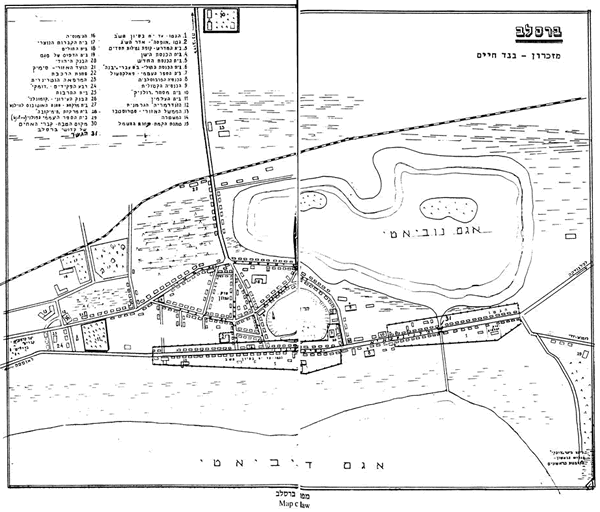
1 - The First Ghetto
2 - Opsa Ghetto
3 - Bet Midrash, Gmiloth Hasidim
4 - Old Minyan (Synagogue)
5 - New Minyan (Synagogue)
6 - Sandy Synagogue, Yavne School
7 - Folkshul
8 - Orthodox Church
9 - Catholic Church
10 - Rolnik Cooperative
11 - Jewish Cemetery
12 - German Gendarmerie
13 - District Administration - Gmina
14 - Police
15 - Mill and Power Station
16 - Gymnasium (High School)
17 - Christian Cemetery
18 - Narbutt Hospital
19 - Magat Printing Press
20 - Jewish Bank
21 - Local Council
22 - Train Station
23 - Veterinary Station
24 - Clerks Residential Quarter
25 - Culture House
26 - City Bank
27 - Pharmacy, Vilna Bus Station
28 - Sejmiko Pharmacy
29 - Polish Popular School
30 - Cattle Market
31 - Food Market
32 - Place of Massacre and Mass Grave
2 - Opsa Ghetto
3 - Bet Midrash, Gmiloth Hasidim
4 - Old Minyan (Synagogue)
5 - New Minyan (Synagogue)
6 - Sandy Synagogue, Yavne School
7 - Folkshul
8 - Orthodox Church
9 - Catholic Church
10 - Rolnik Cooperative
11 - Jewish Cemetery
12 - German Gendarmerie
13 - District Administration - Gmina
14 - Police
15 - Mill and Power Station
16 - Gymnasium (High School)
17 - Christian Cemetery
18 - Narbutt Hospital
19 - Magat Printing Press
20 - Jewish Bank
21 - Local Council
22 - Train Station
23 - Veterinary Station
24 - Clerks Residential Quarter
25 - Culture House
26 - City Bank
27 - Pharmacy, Vilna Bus Station
28 - Sejmiko Pharmacy
29 - Polish Popular School
30 - Cattle Market
31 - Food Market
32 - Place of Massacre and Mass Grave
Map of Braslav during the Holocaust Period - 1941-2

1
22
32
2
9
29
17
11
24
12
13
21
16
17
23
19
25
14
18
8
7
20
10
15
4
5
11
27
6
28
Castle Hill
31
Lake Dryviata

Lake Noviata
30
B
C
D
E
A - Road to Dubene
B - Road to Slobodka
C - Road to Jod
D - Road to Dubkes Forest
E - Road to Opsa
F - The Bridge
B - Road to Slobodka
C - Road to Jod
D - Road to Dubkes Forest
E - Road to Opsa
F - The Bridge
1
3
F
The Holocaust in Braslav
55°38'N, 27°02'E



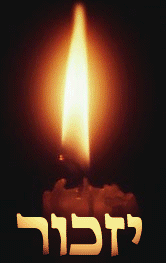
The Death of the Jewish Community of Braslav
'Write down! Record!'
Simon Dubnov
The little told here of the life of the Jews of the Braslav region over centuries would end in short period of satanic German-Nazi rule, which ended in the total destruction of Braslav and the surrounding Jewish shtetlach in Slobodka, Dubene, Jaisi, Jod, Kislowszczizna, Okmienic, Opsa, Plusy, Rimszan, Zamosz, Zaracz at the hands of the Nazis and local collaborators.
A
